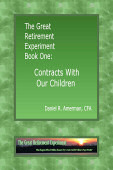 Articles Articles |
The Great Game, Gold Arbitrage & Three Little Pigs
An astute reader from Atlanta named Ken recently wrote the following in a letter to me:
 |
  |
| Take A Walkabout Into Your Future, In The Shoes Of The Person Buying Your Investments.... |
"It seems that the game plan (for financial heavyweights) is to buy assets, real things that can't be papered away by the gov’t, and pay back with depreciated dollars."
Ken gets it. Ken understands the Great Game as it is being played at the highest levels of our monetary system. The Game has two halves: going long the real, and short the symbol. That is, going long real assets by owning them, and going short the dollar and the financial system by selective and advantageous borrowing. That way if you are a hedge fund manager, CEO or “private equity” investor who has essentially gambled the world monetary system on your speculations, and you collapse the financial markets and the value of the dollar when you guess wrong – you don’t jump out the office window. Instead, you enjoy an extraordinarily lucrative early retirement. Because you still own the real – and by destroying the value of the dollar, this just means that you no longer have to pay back most of what you borrowed to buy the real (in inflation-adjusted terms).
As an example, a financial “heavyweight” borrows $1 billion to buy $1 billion in real assets. If asset inflation continues, the asset climbs to $1.5 billion, he sells the asset, pays off the $1 billion borrowing, and walks away with half a billion. If the credit bubble he used to buy the asset unwinds and destroys 80% of the value of the dollar in the process -- no problem! He still owns a real asset that climbs with inflation, so it is now worth $5 billion in future dollars, while he only owes $1 billion. So he sells the asset, pays off the borrowing, and walks away with $4 billion as a reward for his contribution to the credit bubble. (A better way to look at this is in inflation-adjusted terms, where the asset maintains its value at $1 billion, inflation shreds 80% of the value of the $1 billion borrowing, knocking it down to $200 million, and thereby creates $800 million in equity in real terms). There are a number of simplifications in this example, but that is the essence of the Great Game.
The question then is – how do you personally react to this situation? One response is to loudly and frequently express outrage at the situation. That is a most justifiable response. Another response is to take your piggy bank and try to hide it somewhere where it won't be destroyed by the games other people are playing. That is a most understandable response. Still another response is to say: "I wish this wasn't happening, but it is, so how do I personally profit from it?” That is the most advantageous response.
THE THREE LITTLE PIGS
| Click Here To Learn About A Free Mini Course That Will Place This Article In Context & Teach You How To Turn Inflation Into Wealth. |
That "personal profit" part probably sounds pretty good. But, if we personally don't have the millions and billions to directly access the capital markets and play the Great Game – how can we join in the profits? For an answer, we are going to travel back in time, re-examine an old children's story, and explore the little-known key to how millions of households turned inflation into net worth.. The time we will travel back to is the last time inflation raged out of control in the United States, and most particularly, the period between 1972 and 1982, when the dollar lost 57% of its value over 10 years. The children's story is the Three Little Pigs, with the big bad Wolf being played by Inflation. For the Three Little Pigs we will meet three brothers: Dave, Mike, and Jim. Each brother accurately sees the Wolf of Inflation on the way, and each tries to protect himself by building a different kind of financial "house". That is our first variant on the children’s story: we are going to ignore the millions of households who don’t believe the Wolf is coming, and who lose their savings portfolios of straw and wood as a result. Instead, we will concentrate on historical brick-house performance.
(The rest of this article is available as part of the free Mini-Course, "Turning Inflation Into Wealth". The article has been placed in context as part of a series of ten to fifteen minute readings that will cumulatively build your understanding, in an educational process that will lead you towards uncovering new opportunities for personal actions and profits. More information on the free course can be found here.)
This essay and the websites, including the pamphlets, books and audio recordings, contain the ideas and opinions of the author. They are conceptual explorations of general economic principles, and how people may – or may not – interact in the future. As with any discussion of the future, there cannot be any absolute certainty. What this website does not contain is specific investment, legal or any other form of professional advice. If specific advice is needed, it should be sought from an appropriate professional. Any liability, responsibility or warranty for the results of the application of principles contained in the website, pamphlets, recordings, books and other products, either directly or indirectly, are expressly disclaimed by the author.